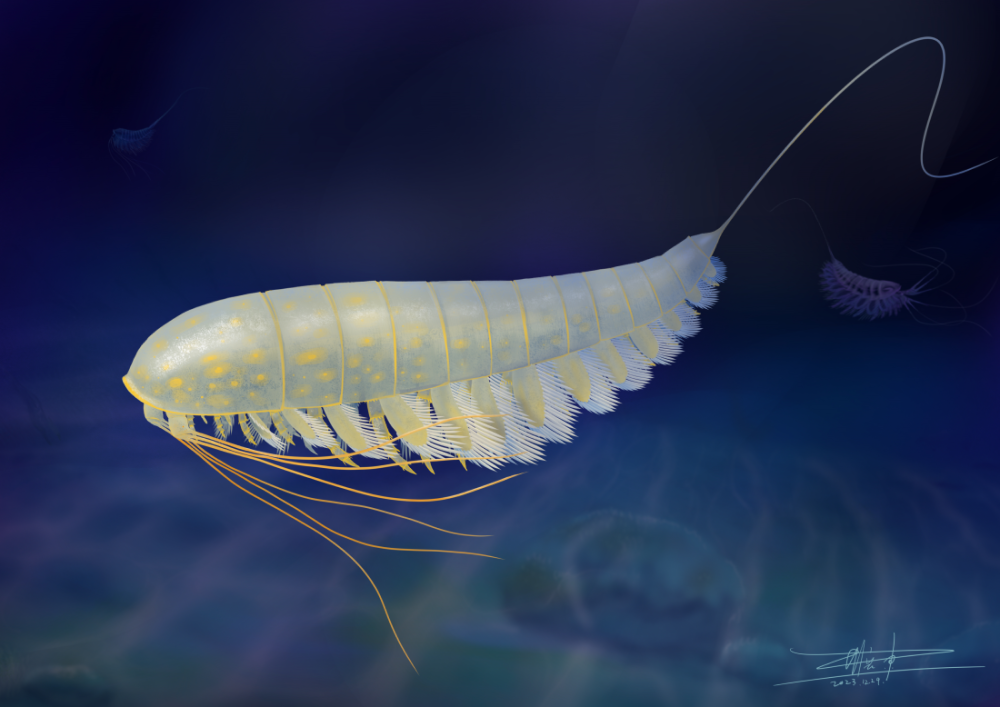Some “extremely rare” fossils that date back 450 million years have revealed a new-to-science species. They were retrieved from a famous fossil site in New York State, USA – and best of all? They’re preserved in glittering fool’s gold.
The new species has been named Lomankus edgecombei, in honor of arthropod expert Greg Edgecombe of London’s Natural History Museum. It sits within a group called the megacheirans, a group of ancient arthropods characterized by a “great appendage” (read: modified leg) that was mostly used to capture prey.
However, Lomankus’s are notably reduced, suggesting that they may instead have used theirs to sense the environment. This adaptability underpins the success of arthropods that have repeatedly risen to environmental challenges by altering the function of their body parts “like a biological Swiss army knife,” as study lead Luke Parry said in a statement.
Megacheirans were common during the Cambrian Period but were thought to have mostly disappeared by the Ordovician Period, which was around 485–443 million years ago. That makes Lomankus’s discovery an intriguing one as it shows that these critters were still diversifying and evolving 450 million years ago at a time that had previously been thought to be a bit of a dead end for the group.

From left to right: photograph of a specimen preserved so that the head is viewed from the top; 3D model of the same specimen rotated so that the underside is visible; photograph of the head of the holotype specimen; digital 3D model of the head of the holotype specimen.
Image credit: Credits: Luke Parry (photographs), Yu Liu, Ruixin Ran (3D models)
The fossils are also fascinating for their preservation in fool’s gold (also known as the mineral pyrite) that forms through a reaction between sulfide and iron. It gets its nickname for the way it closely resembles gold, but it can also come in shimmering hues of silver, chrome, and even rainbow colors. Despite its fancy appearance, it’s not especially valuable (unless you’re into lithium sources) – but it can create fascinating fossils.
“There are lots of types of exceptional preservation but preservation in pyrite of this kind is extremely rare,” IFLScience was told by Parry, who is an Associate Professor within the Department of Earth Sciences at the University of Oxford. “In the last half a billion years there are only a handful of examples.”
The new fossil hails from the Beecher’s Trilobite Bed which is already famous for its “golden” trilobites, but what makes these fossils so rare is that pyritization has occurred in soft parts of the organism. It seems these animals’ corpses struck Goldilocks for the conditions needed for pyritization, providing an exceptional insight into how life looked 450 million years ago.

Life reconstruction of Lomankus edgecombei.
Image credit: Xiaodong Wang
“In life, Lomankus would have been soft (sort of like a shrimp or prawn) and not hardened with biominerals like a trilobite,” continued Parry. “If pyrite hadn’t replaced all of these soft parts, then they would have decayed away and we would have no fossils at all.”
“To form pyrite you need organic material, iron, and a lack of oxygen. The sediments that contain the fossils are low in organic material but high in iron and so the carcasses of the animals were like small islands where the conditions for pyrite to form are just right. The specimens of Lomankus would have been buried alive in a kind of submarine landslide called a turbidite and so this rapid burial ensure that no decay had taken place before they were buried.”
Remarkable as they are, the fossils won’t be easy to maintain. Pyrite oxidizes quickly so specimens can experience “pyrite rot” in museum collections if they’re not stored properly. However, with a little TLC, we can continue to learn about the evolution of life in ancient oceans from these exceptional specimens and the delicate anatomical features they have preserved.
The study is published in the journal Current Biology.
Source Link: "Extremely Rare” Fool’s Gold Fossils Show Soft Tissues Of 450-Million-Year-Old Sea Creature